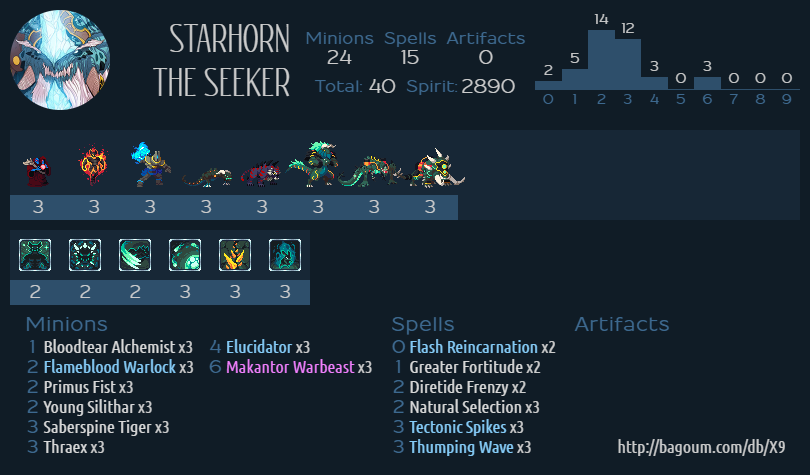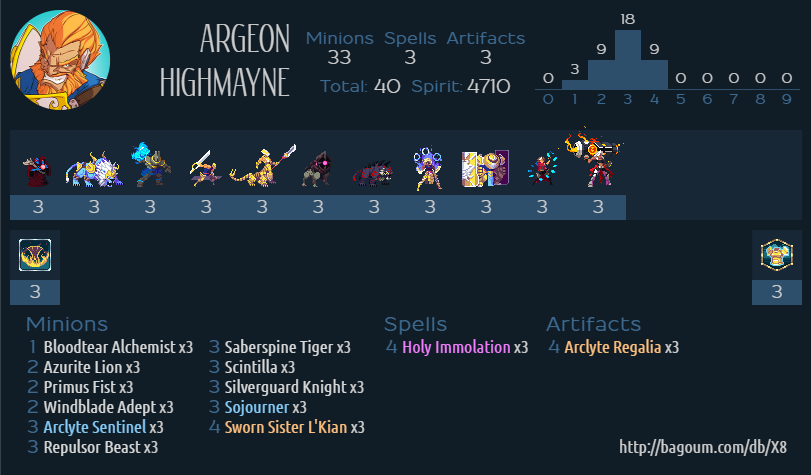"Rise of the Bloodborn" Spoiler Analysis, Sample Decklists, and Aggro Metas
Thunder_God / December 12, 2016
Hello everyone, my username on Reddit and in-game is tundranocaps, and I go as Thunder_God on Discord. For those who don’t know me, I’ve been playing Duelyst since June 1st, making it to S-rank every month except for my first, and have been a long-time competitive player of various TCGs and miniature wargames (including being in my country’s top 20 Magic: the Gathering player for a period of several years while I played). In Duelyst, I mostly play Vetruvian and Songhai, but I like playing all factions, and helping propagate “proper strategy” for the game.
Today I’ll be taking a look at the new cards revealed by PC Gamer from the upcoming Rise of the Bloodborn expansion set. To do so however, requires a pre-amble that discusses several design concepts and past experiences from other similar games on a higher-level than that of singular cards.
1) The Arms Race Everyone Loses:
Before the nerf of Ephemeral Shroud in the mid-October patch, some people had raised the idea of an “Anti-Dispel” mechanic, that specifically counters dispel. The problem with such a mechanic is that if dispel proves too strong, and at some point anti-dispel proves too strong, rather than just going back and forth on people not running dispel into not running anti-dispel, some bright mind would come up with the idea of introducing “Anti-Anti-Dispel”.
Though the semi-hypothetical example above might be a bit extreme, it still gives you an idea for why a counter-spiral is not really good design, because at what point do you stop? I am not arguing against counters, only against counters of a second order. If for instance Night Watcher, an anti-rush card is too prevalent, then Rush would disappear. Rush disappearing would lead to Night Watcher disappearing, which in turn would lead to Rush appearing once more. And so the cycle of the meta-game continues, without the need for adding an anti-Night Watcher, and then an anti-anti-Night Watcher card or their ilks.
2) The War Against Aggro:
Magic: the Gathering, the grandfather TCG, gives the defender the control over trades between minions, and can choose to use their health total to protect their minions (as if they had Provoke on whatever target they wished). Hearthstone, and most digital CCGs that followed instead cede this control to the active player, who is the aggressor. This has led to aggression being much stronger in Hearthstone-styled games (in this aspect, Duelyst is an HS-style game rather than an M:tG-style one) than in classic TCGs.
Designers naturally want to help all deck archetypes be viable, which requires them to try and release anti-aggro cards. The problem with most anti-aggro cards in such games is that they at the same time must be fast enough to counter aggro, strong enough to counter aggro, and somehow not so fast and strong that aggro lists will simply run them themselves to kill off the slower decks. Hearthstone’s Zombie Chow is a perfect example of a card designed to counter aggro, since you wouldn’t want to have a minion that’d let them get back up when they kill it, and is strong for its 1 mana-cost, which ended up co-opted by aggro lists to beat everyone else even harder. Every list had to run this card, and aggro lists did so better.
The meta tends to favour aggression on ladder in particular, because how many games you play is quite important during the grind up to S-rank, while in tournaments a pure win-rate is more important of a consideration. But even so, this game, by its basic core mechanic of non-interaction and player-choice favours aggression, and while we look over the card, we’ll be able to tell how some of these cards that supposedly are there to counter aggression might end up working best in aggressive lists.
3) Card Overview:
- Furosa:

Furosa is a playable 1-drop. This on its own is good. It’s easy to combine this card with the rest of your curve and smooth it out. You’d usually want to save it for a turn where you have your Bloodborn Spell, but with its cost, it’s still quite easy. This means that for Lilithe, her Bloodborn Spell becomes a 2 mana 1/2, and two 2/2s at the very least. That’s pretty good. It doesn’t come as early as Pax does, and an AoE can clear all three at once without requiring anything to pop the cat first, but in terms of value? That’s a very good deal.
More than that, Furosa presents another snowball and “Inevitable Doom” condition to Swarm. The army of 1/1 Wraithlings was eventually going to overwhelm an opponent anyway, but they’d usually back off and keep replacing until they got their Tempest, Plasma Storm, Skorn, or any other form of removal that cleanly dealt with an entire board’s worth of Wraithlings. Furosa on the other hand can very quickly get this board out of hand, for an encroaching win-con that doesn’t rely on a pre-buffed Deathfire Crescendo that is easily removed, or DFC/Soulshatter Pact-related burst.
I really like how this card both gives the list immediate value, additional value if they succeeded in the swarm game-plan of developing a board, and a thematic snowballing late-game value. Because I don’t really see many situations where this card isn’t good, I’d rate it quite highly.
However, note my mention above of how late-game in a topdecking situation, this card can single-handedly put your swarm out of its counters’ reach. This is an anti-counter card, and as such, I am not sure it’s a step in the right direction, design wise. All of its positives might outweigh it, but I’m still worried. But, if the game does indeed devolve into an aggro-fest as I fear, none of this will really matter anyway.
- Stone to Spears:
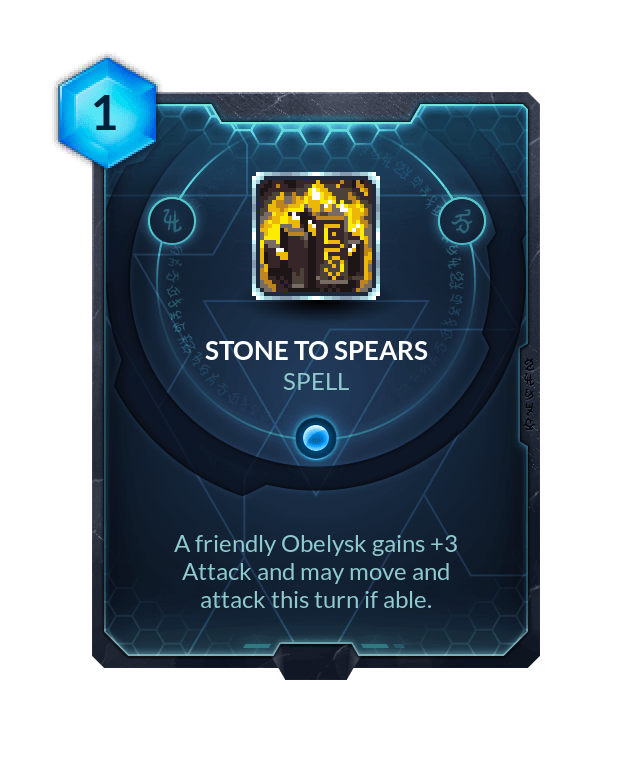
This card follows in Whispers of the Sand’s footsteps, doing away with some of Obelysks’ weaknesses. Whispers helped mitigate Obelysks’ susceptability to dispel effects, and ended up overperforming by giving you a sizeable amount of out of hand burst, and never being useless in topdeck mode due to being a cycle card as well. Stone to Spears seems to try and mitigate Obelysks’ inherent weaknesses as structures, where they can neither move nor attack.
I am not sure how good this card will end up being, because while it is a very strong tempo play, allowing an obelysk to remove most 2 drops (and yes, it takes damage, but it might as well had taken that damage anyway next turn), it’s still trading cards 1 for 1. Being a 1 cost card in a faction with lacking draw can quickly run you out of cards if you are not careful.
Using this card to reposition obelysks, especially late game, is interesting, or for a surprise lethal. 1 mana +3 attack is quite strong. The downside is the Obelysk still needs to survive a turn on board in a position where it could move and attack the relevant target. I ultimately think this card will end up average due to hand-size limits, and just not dealing with Obelysks’ biggest problem right now, which isn’t lack of burst, but Plasma Storm. I’ll definitely mess around with the card, and expect it to be a big buff to more aggressive “face-monkey” Obelysk decks, because more damage can’t hurt.
- Drogon:

Regardless of how good Drogon is, its mere existence will shape how people play. When playing against Vetruvian, unless you know the opponent’s decklist, you always have to respect Star’s Fury. When playing against Vanar, even if the card is unpopular, you have to consider that they just might play Avalanche. With Magmar, at 7 mana-cores, you always have to account for Vaath suddenly getting +8 attack from Bounded Lifeforce. With Drogon, at 9 mana, Drogon + Adamantite Claws + BBS is at the very least 14 damage from Vaath, and 12 from Starhorn, and likely more with Vaath. More importantly, should your opponent play Adamantite Claws on 4 mana-cores, you have to respect they might be able to hit you for 14 damage on 5 mana! That’s crazy.
Drogon is well-statted, and can get value either from its Bloodsurge effect, or simply from being a 5/4 body on 4 mana that demands attention. It also provides synergy with Grove Lion and other tools the faction might bring to bear. As if Magmar’s out of hand burst options that you had to respect weren’t enough, this card will likely push you further away from Vaath, which is how he likes it, pushing you into a corner.
- Scintilla:
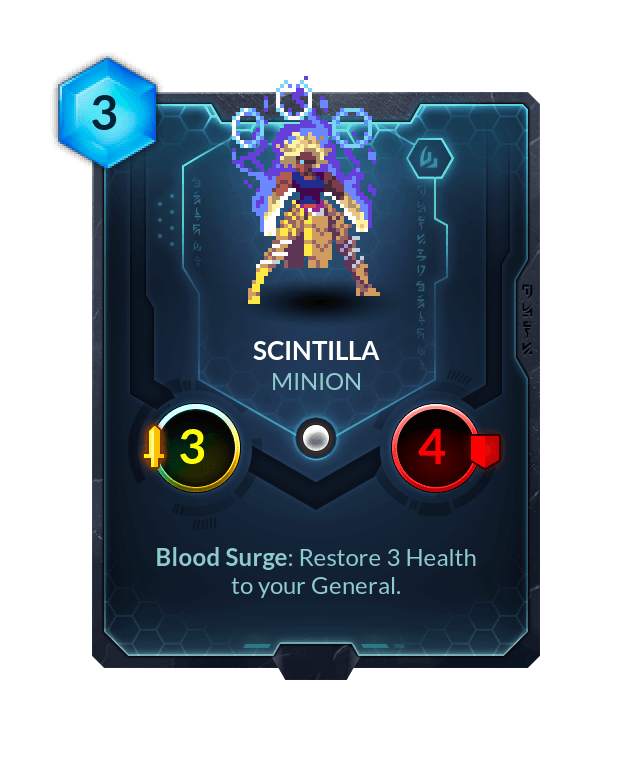
This is a Healyonar card, presumably. More than that, this is an anti-aggro card. 3/4 for 3 is quite a good stat-line that’d allow it to clear out the 3 health 2 drops, and go toe to toe with the opposing 3 drops, while healing your general from all the damage thrown at it earlier. Right?
Well, aggro lists like using their own generals’ faces to clear minions or hit the opposing general. This can help said aggro lists from getting so low where they can get bursted (which is the razor’s edge all aggro lists must dance along in this game). Furthermore, under Argeon with Roar, this minion is quite threatening on its own (5/4 for 4 mana + 3 face heal). Finally, suppose the meta does devolve into an aggression fest, why would you not take a card that can handle itself while also healing you, which gives you the edge twice-over in the face-race?
This card in that sense reminds me of Trinity Oath, revealed over the weekend, where the card seems to be aimed not only at slower decks, but countering aggro, but might find a comfortable home in aggressive lists. Trinity Oath will find a home in Lyonar lists all across the spectrum, but this is another case where “Anti-Aggro” tools might not actually be better at opposing aggro.
The one thing holding both Scintilla and Trinity Oath from being crowned as top picks is that there are already so many good 3 and 4 drops crowding those spots in Lyonar, which these must contend with. But both are very good cards, which could find a home everywhere.
- Concealing Shroud:
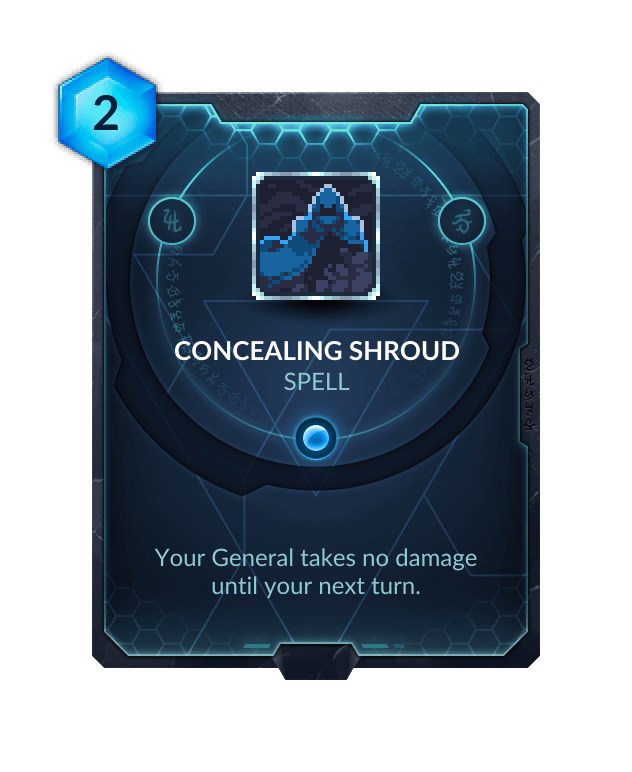
First, the good news. This spell provides a buff to the opposing general, which can be dispelled. While discussing Ephemeral Shroud’s nerf I mentioned how aggro lists tend to not run dispel, and rather run Repulsor Beast. This would make this a good anti-aggro tool, or would slow down aggro lists as they’re forced to use tempo-losing dispel options (Ephemeral Shroud, Lightbender, and Sun Bloom, all of which are tempo-inefficient plays for their mana costs).
The less good news is, this card is the epitome of unfun. Vanar has been the “No” Faction for as long as I’ve been playing, the faction full of cheap and efficient removal. Play a cool big minion? No problem, take it back to your hand. Play it again? It’s a 3/3 now. And let us not forget Gravity Well rendering the game’s “tactical play on a board” into a bad joke as you lose your ability to actually move on and interact with said board. This card is basically saying “Nope!” for the opponent. It’s incredibly powerful, as an additional turn is a lot in this game, and not every deck out there can actually make use of that turn to remove whatever you have on board.
So, is this the anti-aggro solution we needed? Well, you know how if you deal with your pest problem with Nuclear Waste, you indeed have no pests, but also no food? And some toxic waste to deal with? That’s how I feel about this card. Furthermore, the opposing Vanar general can still hit you. Because there’s nothing like Snowpiercer, Concealing Shroud, hitting you in the face, and taking no damage, and no damage next turn either.
Very strong card, for the entire gamut of Vanar lists. But a card I’m deeply unhappy to see, even if it’s “only” a delay, in a game where games routinely end by turn 6, this is huge.
- Twilight Fox:
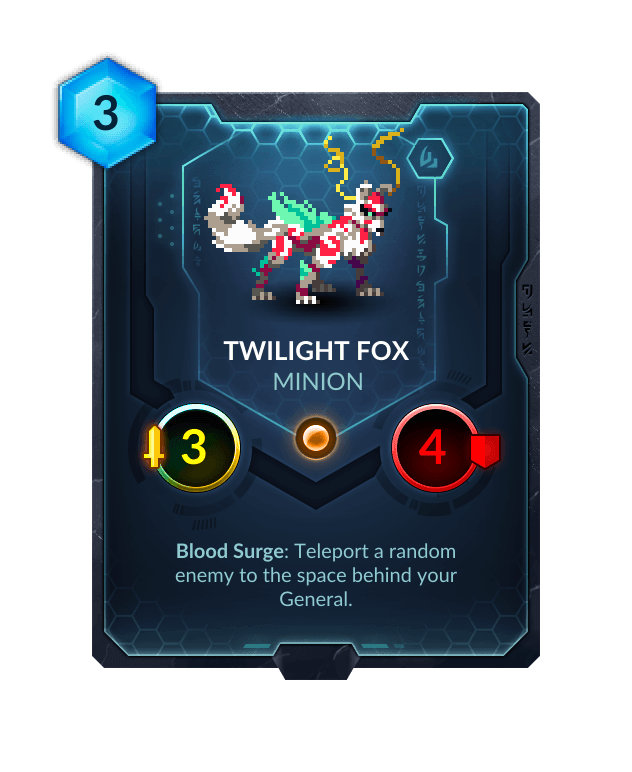
Story time. Today I lost because my opponent played Nature’s Confluence and pulled Gro. My opponent ended the game at 2 HP. Anything other than Gro (and maybe Dex?), and I’d have won that game. This is not an awesome “Story-moment” which RNG sometimes creates, this is the sort of moment that makes you feel robbed. Another small point, but when Grandmaster Zendo was revealed, I said that I hope it won’t be competitive, as losing to it would feel terrible. Zendo is indeed playable, and losing to it indeed feels much worse than losing to cards that are equally powerful. At least to me.
Twilight Fox is going to be a bit like that. If it’s good, it’d feel terrible to lose to it pulling your general, into it being backstabbed (not by Mask of Shadows, that card’s terrible, by Katara), or into a corner where you’re surrounded by minions and can no longer do anything on the board. If it’s not good, it’d feel even worse to know someone played it and got lucky and pulled this on you.
Being a 3/3 for 3 mana, Twilight Fox isn’t terrible, on stats alone, but it’s worse than most other 3 drops in Songhai, which are the faction’s already over-crowded power-spot, both in terms of minions, and in terms of spells. But it’s going to see play. And it’s going to pull the worst possible target for the non-Songhai player. And they’ll close the game and walk away for the day.
I do like that it gives Songhai something to do about people who try to protect units such as Kelaino, heartseekers, or their general away, but for a faction with Juxtaposition and Mist Dragon Seal, there are much more consistent ways of doing so, so I agree with the PC Gamer article that this will mostly be used to troll your opponents, something which I wish were to cost more mana, and not fill Songhai with yet another underwhelming legendary.
4) Deck Lists:
Note, these decklists are highly unrefined, and are mostly to give you an idea of what the “Face Race Meta” might look as. The Starhorn list in particular seems to me like it’d be exceedingly strong, and follows CrankyPanda’s logic of playing Starhorn allowing you to cut down on draw cards. Tectonic Spikes, mistake it not, isn’t a card for Visionar and Vindicator combos, but a card to keep fueling aggro while also dealing 3 unpreventable damage.
The Lyonar list might honestly be better without Scintilla, replacing it for Slo to keep the opponent locked down in place or allow you even better Holy Immolations, but I wanted to give an example showcasing a more aggressive list making use of it.
